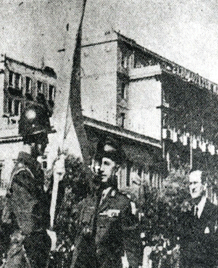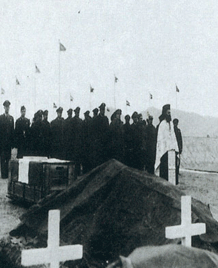 Greece
Greece
List for UN Allies
Background of Participation
The Greek government decided on July 20, 1950 to dispatch six C-47 transport planes and one infantry brigade of 3,800 soldiers after the UN Secretary-General had asked for support of South Korea. As the war situation in the Korean peninsula was turning favorable to the UN side, the US Joint Chief of Staffs suggested that Greece reduce the size of the infantry unit from brigade to battalion. Thus, the Greek government selected soldiers with combat experiences among the brigade soldiers, and organized one battalion.
On October 13th, Greece organized the 13th Transport Squadron with six C-47 and 67 soldiers, which arrived in Japan and was attached to the US 5th Air Force. The infantry battalion arrived in Pusan on December 9th. After a welcoming ceremony, the Greek soldiers moved to the UN camp at Kimhae, in which they were supplied with equipment. The Battalion was attached to the US 1st Cavalry Division on December 30th.
Activity of the Ground Forces
On February 24th, after moving to Ichon, the Greek Battalion launched an attack aimed at Ichon-Konjiam-Kyonganri. On the 26, the Greek soldiers were attacked by the enemy near Sojong-ri, in which 4 died and 2 wounded. Nevertheless, the Battalion occupied the Hills of 381, 307, and 258 on February 28th.
After maintenance in Dongduchon, the Battalion participated in Operation Commando, and attacked the Hill Scotch near Sonbyok, west of Cholwon on October 3rd. But it retreated from the region due to Chinese counterattacks which caused 14 deaths. On October 5th, the Battalion resumed an attack after air and artillery strikes, and occupied the Hill. In the fighting, the Battalion killed 150, and captured 12 wounded prisoners. But it also suffered 105 casualties. The Greek units achievement in this battle was honored by citations from USA and ROK Presidents.
As the US 1st Cavalry Division was preparing to leave for Japan, the Battalion was assigned to the US 3rd Division on November 28th. Around that time, the Greek Battalion also reorganized its units.
The Battalion moved to the west of the Imjin River, and re-deployed in the Kojan-ri region on January 19, 1952. The Greek army engaged in a fierce fighting with CCF on the Hill Kelly on March 2nd. It also fought for positions on the Hills of Kelly, Nori, and Betty, and repelled the enemy on March 17th. After the battles, the Battalion concentrated its effort on maintenance and training as a reserve unit for 4 months from March 19th.
As Chinese forces initiated the Fall offensive, the Battalion was deployed in the Hill Sonori, west of the Imjin River on September 26th in order to attack the Hill Daenori. After shelling enemies defensive points in Koyangdae, the Hill Daenori, and the Hill 117 at dawn on the 28th, the 1st Platoon of the 2nd Company attacked and occupied the Hill Daenori. But the platoon retreated from the hill when CCF resumed attacks on the same day.
On January 29, 1953, the Greek Battalion was deployed along the main resistance line in Hajin-ri, northwest of Kimhwa. The reconnaissance unit of the Battalion engaged Chinese forces on Hill 420 on February 9th. The reconnaissance unit killed 20 Chinese soldiers north of Hill 438 on March 11th, but 6 Greeks were also killed with 7 wounded.
Around June 10th, the US 3rd Division and CCF engaged in a desperate combat to capture the 420-meter Hill Harry, which could exert influence on the settlement of the armistice line. At midnight of June 17th, a day after the Greek Battalion had been deployed in this region, Chinese troops attacked the Hill Harry. After 5 hours of fighting, the Battalion killed 500 enemy soldiers.
As the Communist forces launched the July offensive, the Battalion was deployed in the hilly areas, south of Bukjongryong on July 14th. Three days later, Chinese troops, after failing in the first attack at 04:00, launched a surprise daytime attack at 15:00. The Battalion engaged in bloody fighting under artillery covering, and repelled the enemy. Only three days before the armistice, CCF made two attacks, but the Battalion defeated them all. The Battalion killed 150 and captured 27 prisoners though suffering 19 deaths and 28 wounded.
Activity of the Air Force
The 13th Transport Squadron was assigned to the US 315th Combat Transport Air Division, and dispatched to the Yonpo base on December 4, 1950. The Squadron airlifted 193 tons of supply and carried back 800 casualties. In the middle of December, the squadron supported the US 10th Corps in retreating from Heungnam.
The squadron moved from the Suyoung base to Kimpo Airport on May 14, 1951, as UN forces advanced to the 38th parallel. The squadron carried out its duty of transportation despite bad climate and short runways in Yoju and Wonju. In August, the air squadron began the operation of supporting the Baekryong Island, which was a strategic point on the Yellow Sea. The squadron had difficulties in landing and taking off because the island was close to the enemy, and because planes could use the natural runway only at low tide.
On December 22nd, a transport plane piloted by the commander of the squadron collided with a US aircraft in Suwon airport, in which 5 crew members and 5 American wounded soldiers on board were died.
Furthermore, another plane piloted by an acting commander, crashed against the peak of a hill, causing 14 deaths. From February 1953, the squadron carried out the mission of supplying armed forces and commodities gathered in Daegu and Kimpo to the front. The Greek squadron continued its mission after the armistice.
Greece participated in the Korean War with 10,581 soldiers, among which 188 were killed and 459 wounded. The Air Force withdrew in May, and the Army in December 1955.


